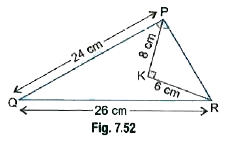Theorem 6.9 : In a triangle, if square of one side is equal to the sum of the squares of the other two sides, then the angle opposite the first side is a right angle.
Given:- A B C is a triangle
AC2=AB2+BC2
To prove: -∠B=90∘
Construction:- Construct a triangle P Q R right angled at Q such that, P Q=A B
and {QR}={BC}
Proof:-
In triangle {PQR}
{PR}2={PQ}2+{QR}2 (By pythagoras theorem)
⇒{PR}2={AB}2+{BC}2......(1) (because {AB}={PQ} and {QR}={BC})
{AC}2={AB}2+{BC}2.....(2) (Given)
From equation (1) (2), we have
AC2=PR2
⇒ A C=P R....(3)
Now, in triangle {ABC} and triangle {PQR}
A B=P Q
{BC}={QR}
A C=P R ( From (3))
therefore triangle {ABC} cong triangle {PQR} (By SSS congruency)
Therefore, by C.P.C.T.,
∠{B}=∠{Q}
because∠{Q}=90∘
therefore ∠{B}=90∘
Hence proved.
Topper's Solved these Questions
Similar Questions
Converse of Pythagoras theorem : In a triangle; If the square of one side is equal to the sum of the squares of the other two sides., then the angle opposite to the side is a right angle.
View SolutionIn a triangle, if the square on one side is equal to the sum of the squares on the other two sides, prove that the angle opposite to the first side is a right angle. Use the above theorem to find the measure of ∠PKR in Fig. 7.52.

View Solution
Knowledge Check
In a traingle, if square of one side is equal to the sum of the squares of other two sides, then the angle opposite the fitst side is :
A60∘B90∘C45∘D30∘If in a triangle, square of one side is equal to the sum of squares of the other two sides, then the angle opposite the first side is :
A60∘B90∘C45∘D30∘
Rahul is studying in X Standard. He is making a kite to fly it on a Sunday. Few questions came to his mind while making the kite. Give answers to his questions by looking at the figure
In a triangle, if square of one side is equal to the sum of the squares of the other two sides, then the angle opposite the first side is a right angle. This theorem is called as,APythagoras theoremBThales theoremCConverse of Thales theoremDConverse of Pythagoras theorem
Theorem 6.8 : In a right triangle, the square of the hypotenuse is equal to the sum of the squares of the other two sides.
View SolutionIf the square of one side of a triangle is equal to the sum of the squares of the other two sides then the triangle is a right triangle with the angle opposite the first sides as right angle.
View SolutionProve that is a right angle triangle, the square of the hypotenuse is equal the sum of the squares of other two sides.
View SolutionPYTHAGORAS THEOREM : In a Right angled triangle; the square of hypotenuse is equal to the sum of the squares of the other two sides.
View SolutionProve that in a right triangle, the square of the hypotenuse is equal to the sum of the squares of the other two sides.
Use the above theorem, in the following.
If ABC is an equilateral triangle with AD⊥BC, then prove that AD2=3DC2.
View Solution